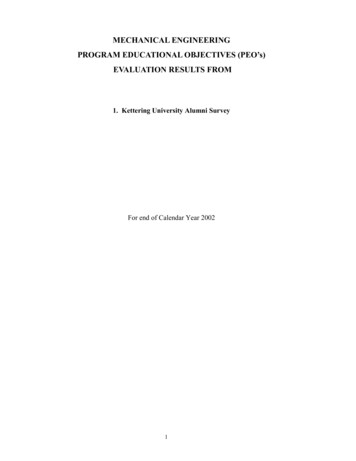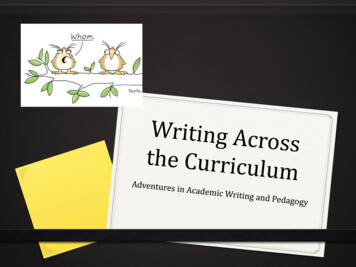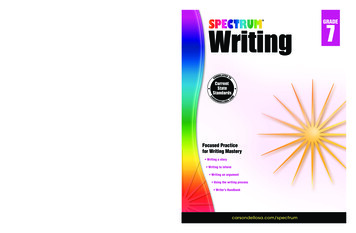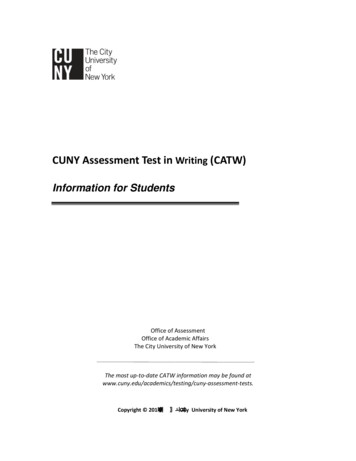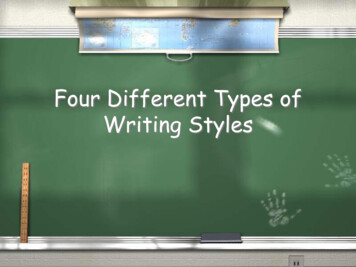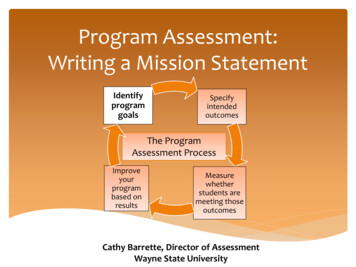
Transcription
Program Assessment:Writing a Mission esThe ProgramAssessment ProcessImproveyourprogrambased onresultsMeasurewhetherstudents aremeeting thoseoutcomesCathy Barrette, Director of AssessmentWayne State University
Presentation OverviewTo help you write a mission statement, this presentationprovides: an explanation of what a mission statement is examples from Wayne State’s academic and studentservices programs guiding questions to help your program develop amission statement pitfalls to avoid when developing a mission statement
Mission Statement A brief description of the program’s: Purpose - Why the program exists, including its broadgoals and unique or signature features Offerings– What kinds of opportunities students or clientswill have for achieving the program’s goals (e.g.,coursework, internships, service learning) Target audience/Stakeholders – Who benefits from theprogram Aligned with university and division missions Realistic and achievable
Usefulness A mission statement is like a guiding principle:explicitly articulating it helps guide programmaticdecisions. For example, you can use your mission statement to Prioritize your use of and requests for funding, facultylines, course offerings, extra curricular programs Decide which courses should be required or elective Identify new areas of expansion
Example: BFA in DanceThe mission of the BFA Program in the Maggie AlleseeDepartment of Theatre and Dance is to [prepare] [students][for professional careers in dance.] The Program providespreparation for pursuits in [performance, choreography andproduction through practical study of dance techniques,theoretical and historical studies, exploration of currenttrends in the art and frequent engagement with professionaldance artists.] The program provides [abundant performanceexperiences] for [BFA students as it serves the urbanmetropolitan community] in which Wayne State Universityresides.
Example: MS in TaxationOur mission is to [prepare] [students] [for careersrequiring a high degree of specialized tax knowledge][in public accounting, private industry, and governmentby emphasizing a thorough grounding in the principlesof tax research, corporate taxation, and flow-throughentities as well as ethics and professionalcommunications.]
Example: PhD in Biochemistry andMolecular BiologyThe mission of the PhD program in Biochemistry andMolecular Biology is to train [graduate students] through[advanced course work, critical analysis of the primaryliterature and apprenticeship to a practicing scientist] to[develop an understanding of the theoretical and practicalaspects of biomedical research. Special emphasis is placedupon critical thinking and written and oral communicationskills to further prepare graduating students to pursue avariety of different career options] where a thoroughunderstanding of research is essential.
Example: UG Certificate inNanoengineeringThe nanoengineering certificate program offers students[multidisciplinary, in-depth training in the emergingtechnological area of nanotechnology] by offering new [lecture,laboratory, and seminar courses that cross traditionaldepartmental and disciplinary boundaries. Students gain handson experience with advanced instrumentation and cleanroomoperation. Students conduct research with faculty and industrialpartners.] The certificate program [fulfills the educational needsof working engineers and technical professionals], targetingespecially those in the Metro Detroit area and Windsor, Canada.
Example: Academic Success Center The mission of the Academic Success Center is toensure that [all Wayne State University students]become [self-determined, motivated andindependent learners.] We accomplish this through[tutoring, Supplemental Instruction, individualinstruction and workshops] that support students’development of skills to achieve academic excellence.
Example: Learning Communities[To support Wayne State University’s commitment tostudent learning and retention], the LearningCommunity Initiative seeks to [enhance] our[undergraduates’] [experience] by providing all[interested students] [dynamic, focused communities inwhich students, staff, and faculty learn and growtogether].
Mission Statement:Guiding QuestionsTo help you get started on your mission statement, youmight discuss the following questions with yourcolleagues: What need(s) does the program fulfill? What kinds of learning opportunities does theprogram provide? What does this program uniquely offer thatdifferentiates it from other programs?
Mission Statement:Pitfalls to AvoidWording that is: Too general, applicable to any program Descriptive of a department or unit rather than onespecific program Focused on teaching or research rather than studentlearning Written for a specialist/expert audience rather than ageneral audience
Want More Information? Additional presentations and theassessment handbooks explain howto: Write mission statements Write learning outcomes and curriculummaps Choose assessments Understand and use results Use Planning to record your work Each part has examples and pitfalls toavoid as well!
Local Resourcesfor Program Assessment Cathy Barrette, WSU Director of Assessmentc.barrette@wayne.edu(313)577-1615 WSU Assessment website Office for Teaching and Learning staff, workshops andwebsite
A mission statement is like a guiding principle: explicitly articulating it helps guide programmatic decisions. For example, you can use your mission statement to Prioritize your use of and requests for funding, faculty lines, course offerings, extra curricular programs Decide which courses should be required or elective



